沪教版英语七年级上册精品教案Unit 2Period 2
初中英语沪教版七年级上册Unit2《The simple present tense 》优质课公开课教案教师资格证面试试讲教案
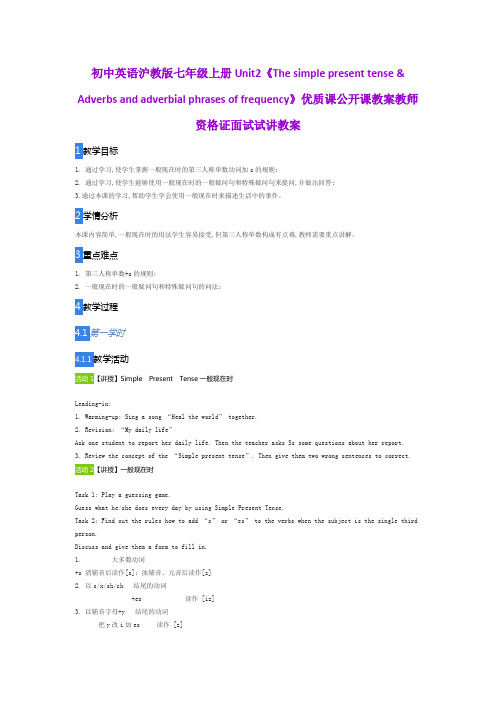
初中英语沪教版七年级上册Unit2《The simple present tense & Adverbs and adverbial phrases of frequency》优质课公开课教案教师资格证面试试讲教案1教学目标1. 通过学习,使学生掌握一般现在时的第三人称单数动词加s的规则;2. 通过学习,使学生能够使用一般现在时的一般疑问句和特殊疑问句来提问,并做出回答;3.通过本课的学习,帮助学生学会使用一般现在时来描述生活中的事件。
2学情分析本课内容简单,一般现在时的用法学生容易接受,但第三人称单数构成有点难,教师需要重点讲解。
3重点难点1. 第三人称单数+s的规则;2. 一般现在时的一般疑问句和特殊疑问句的问法;4教学过程4.1第一学时教学活动1【讲授】Simple Present Tense一般现在时Leading-in:1. Warming-up: Sing a song “Heal the world” together.2. Revision: “My daily life”Ask one student to report her daily life. Then the teacher asks Ss some questions about her report.3. Review the concept of the “Simple present tense”. Then give them two wrong sentences to correct.2【讲授】一般现在时Task 1: Play a guessing game.Guess what he/she does every day by using Simple Present Tense.Task 2: Find out the rules how to add “s” or “es” to the verbs when the subject is the single third person.Discuss and give them a form to fill in.1. 大多数动词+s 清辅音后读作[s]; 浊辅音、元音后读作[z]2. 以s/x/sh/ch 结尾的动词+es 读作 [iz]3. 以辅音字母+y 结尾的动词把y改i加es 读作 [z]。
牛津上海版七年级上册U2教案
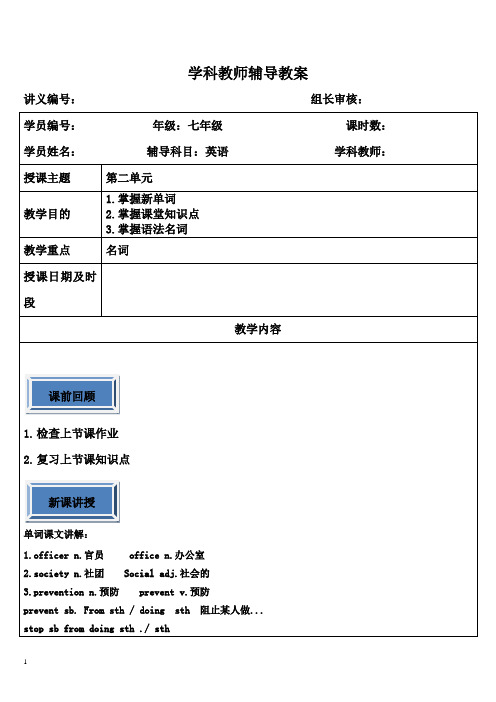
5、名词所有格 名词所有格(possessive case)表示人或物的所属关系。主要有三种形式:’s 形式, of +名词形式 和双重所有格形
名词
专有名词(Tom,Shanghai,USA, UN)
举例
普通名词
可数名词
个体名词
person,desk,
集体名词
audience,crew
不可数名词
物质名词
stone,iron
抽象名词
glory,quality
2、名词复数的规则变化
3
名词单数的特征
复数构成方法
举例
规则名词
在名词单数后直接加-s
式 1) ’s 形式 所有格
即:表示有生命的东西的名词的所有格
表示有生命的东西的名词(人或动物)的末尾,加上's,即构成所有格,可放在另一名词之前,作定语用。如:
John's friend 约翰的朋友
Xiao Wang's notebook 小王的笔记本
children's books 儿童读物
my father's room 我父亲的房间
knife---knives life---lives
leaf---leaves
wolf---wolves thief---thieves;
有些,直接加-s
belief---beliefs
roof---roofs safe---safe s gulf---gulfs;
Unit2教学设计2023-2024学年牛津上海版英语七年级上册
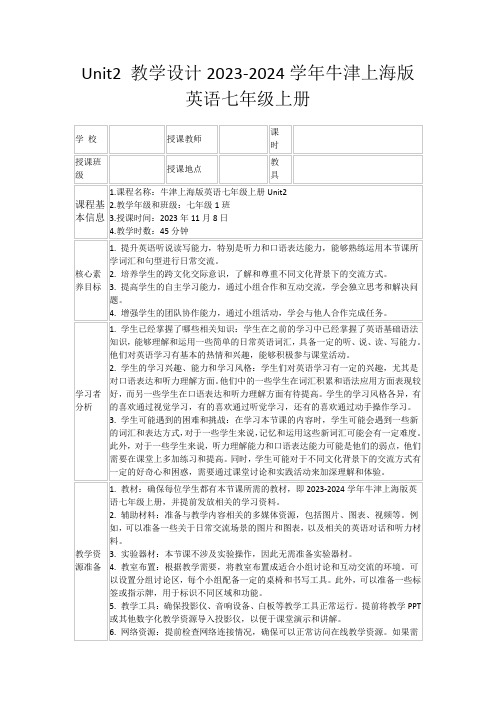
反思改进措施
在刚刚结束的《Unit2教学设计2023-2024学年牛津上海版英语七年级上册》的课程中,我尝试了许多新的教学方法和策略,希望能够激发学生的学习兴趣并提高他们的英语水平。现在,我将对我的教学进行反思,并提出一些改进措施。
首先,我认为本节课的最大特色是引入了大量的实际生活中的场景和例句,让学生能够更好地理解和应用所学的词汇和句型。我也尝试了分组讨论和角色扮演等多种教学方法,让学生能够在实践中提高他们的英语能力。此外,我也利用了多媒体教学资源,如PPT和视频,来辅助我的教学,希望能够增加学生的学习兴趣。
然而,我也发现了一些主要问题。首先是教学管理方面,我发现有些学生在小组讨论和角色扮演时注意力不集中,这可能是因为他们对这些活动不感兴趣或者缺乏参与感。其次,在教学方法上,我发现对于一些学生来说,过多的听力和口语练习可能会造成他们的疲劳和压力,他们可能更需要一些时间和空间来消化和理解所学的知识。最后,在教学评价上,我意识到仅仅依靠课堂表现和作业完成情况来评价学生的学习成果是不够的,我需要找到更全面和准确的评价方法来了解学生的真实学习情况。
二、新课讲授(用时10分钟)
1.理论介绍:首先,我们要了解本节课的主要内容——日常英语交流的基本句型和词汇。这些句型和词汇是英语交流的基础,它们可以帮助我们更好地表达自己的想法和需求。
2.案例分析:接下来,我们来看一个具体的案例。这个案例展示了如何在实际场景中运用所学句型和词汇进行交流,以及它如何帮助我们更有效地沟通。
针对以上的反思,我将采取以下改进措施。首先,在教学管理方面,我将尝试更多的方法来提高学生的参与感和注意力,比如通过小组竞赛或者角色扮演的游戏等方式。其次,在教学方法上,我将更加注重学生的个体差异,根据他们的学习需求和风格来调整我的教学方法和节奏。最后,在教学评价上,我将采取更多的评价方式,如学生自我评价、同伴评价和定期考试等,来全面了解学生的学习成果。
牛津上海版七年级英语上册教学设计:Unit2Ouranimalfriends

4.布置课后作业,如让学生写一篇关于自己最喜欢的动物的小短文,巩固课堂所学知识,培养学生的写作能力。
五、作业布置
为了巩固本章节所学知识,培养学生的语言实际运用能力,特布置以下作业:
1.请学生根据自己的喜好,选择一种动物,运用本节课所学的词汇和句型,写一篇关于该动物的小短文。要求描述动物的外貌、特点、习性和技能,不少于80词。
d.鼓励学生课后参加与动物相关的实践活动,如参观动物园、做动物保护志愿者等,将所学知识与社会实践相结合。
四、教学内容与过程
(一)导入新课(500字)
1.教师以生动有趣的故事引入新课,例如:“Once upon a time, there was a clever dog named Biscuit. He could do many interesting things, such as fetching a ball, shaking hands, and even dancing. Today, we are going to learn about our animal friends and their amazing skills.”(从前,有一只聪明的狗叫饼干。它会做很多有趣的事情,比如捡球、握手,甚至跳舞。今天,我们将要学习关于我们的动物朋友和它们的神奇技能。)
4.鼓励学生在日常生活中用英语与他人交流,增强学生的跨文化意识,提高学生的国际视野。
二、学情分析
针对牛津上海版七年级英语上册Unit2 Our animal friends这一章节,学情分析如下:七年级学生正处于青春期,他们对新鲜事物充满好奇,尤其对动物有着浓厚的兴趣。在此基础上,学生对本章节的学习将表现出较高的积极性和参与度。然而,学生在英语语言基础、学习方法和情感态度方面仍存在一定差异。
上海版英语七年级上Unit2Dailylife教案
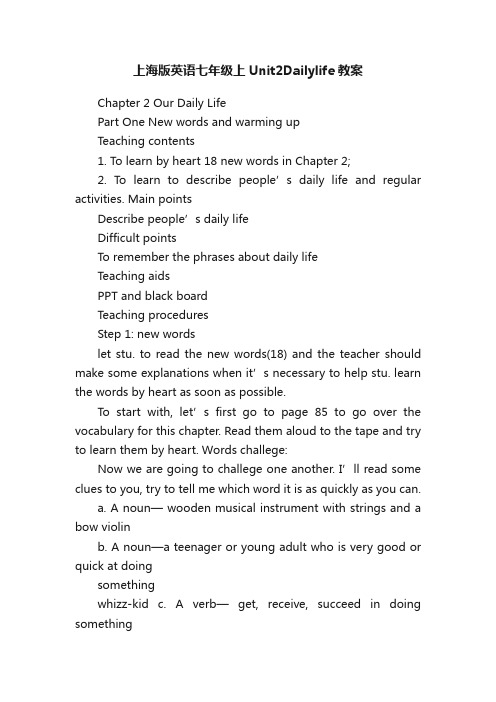
上海版英语七年级上Unit2Dailylife教案Chapter 2 Our Daily LifePart One New words and warming upTeaching contents1. To learn by heart 18 new words in Chapter 2;2. To learn to describe people’s daily life and regular activities. Main pointsDescribe people’s daily lifeDifficult pointsTo remember the phrases about daily lifeTeaching aidsPPT and black boardTeaching proceduresStep 1: new wordslet stu. to read the new words(18) and the teacher should make some explanations when it’s necessary to help stu. learn the words by heart as soon as possible.To start with, let’s first go to page 85 to go over the vocabulary for this chapter. Read them aloud to the tape and try to learn them by heart. Words challege:Now we are going to challege one another. I’ll read some clues to you, try to tell me which word it is as quickly as you can.a. A noun— wooden musical instrument with strings and a bow violinb. A noun—a teenager or young adult who is very good or quick at doingsomethingwhizz-kid c. A verb—get, receive, succeed in doing somethingachieved. A noun—customer; someone who buys something or uses a service cliente.A verb—talk about something discussf. A noun—a person who controls a business or part of it. managerg. A noun—the person (in a company) who looks after the money and keeps the financial recordsaccountanth: in the morning a.m.i: in the afternoon p.m. j: help sb. do sth. assist k: go to attend l: a company business Step 2: warming-up by looking at the picturesLook at the pictures and to know the phrases about daily life describing on the picturesThen ask the students what do they do every day, every week(use phrase) show PPT to students when they answer the questions(the phrases about daily life describing)Step 3: work in pairs to describing Ss’ daily lifelet’s Ss work in pairs to describe What kind of things do they do every day? What kind of things do they do once or twice a week? And what kind of things do they never do?write these patterns on the blackboard:I……every day.I……once or twice a week. I never ……(Encourage students to speak up their daily activities as many as possible.)e.g. A: What kind of things do you do every day?B: I clean my teeth, wash my face and hands, make a telephone to my parents, watch television, go to school, do myhomework every day.A: What kind of things do you never do every day?B: I never play the piano, ride a bike, go to the supermarket, argue with other classmates, come to school late.A: What kind of things do you do once or twice a week?B: I eat fish, play tennis, play computer games, go to the concert, eat chocalates, take a bus once or twice a week.Step 4: Homework1. Preview the Reading in Chapter 2;2. Learn the new words by heart.Part Two Reading (1)Teaching contents:1.How to describe our everyday activities and how often we do things. 2.The daily life of a ‘whizz-kid’ student Main pointsRead the text and abstract the important information from the text Difficult pointsChange the information into chartTeaching aidsmultimedia, tape-recorder, PPTTeaching produceduresStep 1: leading-inAsk the students when they usually get up in the morning, when they go to school and so on . Then lead in the topic of this chapter ‘ Our Daily Life’. And show them some pictures and let them do the ‘ask and answer’activity.Which of these things do you do every day / do once or twice a week / never do?Step 2: pre-readingLet students talk about their daily life, and then compare withthe lifeof Wendy (look at the picture).Step 3: while-readinga. Skim the text and use one sentence to abstract the main idea of the text.b. Scan the text and to get the main idea of each paragraph, finish this chartP1 Wendy describes her school. She finds some school work easybut boring.P2 At lunch-time she sometimes has lunch with a business client.P3 Wendy describes her morning routin and the background toher family computer business.P4 Wendy’s driver takes her to school in her own car.P5 In the evenings she works on her computer games.P6 Wendy describes her after-school activities.c. Read the text again and find the facts. Turn to page 18 complete the list with information that Wendy gives us in her article. Write only notes (one to three words or figures) for each answer.1. What she writes computer games2. when she gets up 6 a.m.3. How she gets to school 7.30 a.m4. How she gets to school in her car5. What she does on the way makes phone calls6. Her usual grade at school A7.when she goes to Computer Club Friday8.when she has dinner 7 p.m.9.Her work after dinner writing computer games10.when she goes to bed 11 p.m.Step 4: post-readingAsk the students to read the passage again and do the exercises on page 19 in the book.Step five: summary1.how to talk about our regular activities we do every day or every week/ month2.what does Wendy do every day?Step 6: homeworkExercise book page 13-14Do a survey of “how often do you…” (see in PPT)Part Three Reading (2)Teaching contentsLanguage points in the textTeaching aims and demandsTo find out and analysis the usage of language points (phrases and words) Main points14 phrases and 4 words usagesDifficult pointsPut on/ wear/ have on the difference among them, assist, attend Teaching aidsPPT and black boardTeaching proceduresStep 1: warming-upListen to a song: Here I amStep 2: language points learninga.the top studentb.must bec.businessd.put on/wear/have one.have breakfast/lunch/dinnerf.discussg.in my own carh.make a phone calli.on the way toj.enjoy doing sthk.achievel.fail an examm.twice a weekn.attendo.have computer club meetingp.assist sb with sthq.continue to do sth/continue doing sthExpain them one by oneStep 3: HomeworkExercise book page 15;Preview the Language in Chapter 2.Part Four LanguageTeaching contents1. How to use verbs in the simple present tense to talk or write about things happening all the time or a number of times.2. How to use adverbs and adverbial phrases to say how often things happen. Teaching aidsmultimedia, tape-recorder, PPTTeaching produceduresStep 1: leading-inAsk the students what Wendy usually do in his daily life. Then lead in the language of this chapter ‘ the simple present tense’.Give them some sentences of the simple present tense, and ask them to find out the structure of the tense.Step2:1.help them find out the structure of the simple present tense肯定句:主语+am/is/are+其它成分.主语(除第三人称单数)+动词原形+其它成分.否定句:主语+am/is/are not+其它成分.主语(除第三人称单数) +don’t+动词原形+其它成分.一般疑问句:Am/Is/Are+主语+其它成分?Do +主语(除第三人称单数) +动词原形+其它成分?特殊疑问句:疑问词+is/am/are +主语+(其它成分)?疑问词+do +主语+动词原形+(其它成分)?The consistent of simple past tensea. I like fish./he likes fish.I am a student.b. I don’t like swimming./they are not in the library.c. is it a tall tree?/ does the earth go around the sun?d. What time is it now?2. help them to find out the rules of verb changea. –sb. s, x, sh, ch, o –esc. constant songs+y -ies3. do some exercisesStep 3:1. read the sentenses in the book and find out the usage of the adverbs and adverbial phrasesFind out the difference of the words:always --- usually --- often --- sometimes --- seldom --- never2. do some exercisesStep 4: consolidationDo exercisesStep 5: summary1.How to use verbs in the simple present tense to talk or write aboutthings happening all the time or a number of times.2.How to use adverbs and adverbial phrases to say how often things happen. Step 6: homeworkExercise book page 15-16Part Four Listening & SpeakingTeaching contents:Get the students to know some listening skill ( make notes).Get the students to know how to describe a daily life.How to describe our everyday activities and how often we do things. Teaching aidsmultimedia, tape-recorder, PPTTeaching producedures:Step one: Lead in and pre-listeningwhat does your father or mother do every day?Predicting: where, when, whatStep two: while-listening1.play the tape for the first time. Get the students to know the generalidea of the listening material with writing anything.2.students listen for the second time and work out which person is talking.Then check the answer.3.play the recording again and ask students to complete partB.Step 3: post-listening1.hand out the tapescript and find out the words they listen to.2.read the tapescript.Step 4: speakingAsk the students about the daily life of Wendy, let them use the Yes / No to answer the questions.1. Is Wendy still a student?2. Does Wendy drive herself to school?3. Does Wendy fail an exam?4. Can Wendy play the violin?5. Does Wendy have breakfast at 7:30 a.m.?6. Does Wendy like her school friends?Step 5: presentation1.Ask the students to pay attention to the teacher’s voices.When we ask a Yes/No question, we make our voices rise at the end. Also we make our voices rise to show politeness.2. ask them to do some practice.Step 6: speak-upWork in pairs to find out about your classmate’s habits. Ask your partner the questions and write down the answers.Step 7: homeworkExercise book page 18-19Part Five WritingTeaching contentsHow to write about a person’s daily life.Teaching aidsmultimedia, PPTTeaching produceduresStep 1: leading-inRetell the story of Wendy using the simple present tense.Review what we learnt in chapter 2 and arouse students interest towards the topic.Step 2: discussionGive some key words and ask them how to write them into a correct sentence.1.play basketball, her friend, from 4.00 to 4.30 p.m., at school, oncea weekShe plays basketball with her friend from 4.00 to 4.30 p.m. at school oncea week.2.live nearby, always walk to school, go to school, 7.45 a.m., usuallyarrive, 8 a.m.She lives nearby and always walks to school. She goes to school at 7.45 a.m. and usually arrives at 8 a.m.Step 3: write a sentence correctlyExercise in the book on page 27.Step 4: writing a short story about a girl’s everyday life. Fangfang is my best friend. She lives a healthy life. She gets up at six o’clock every morning…Step 5: summary1. how to write about our regular activities we do every day or every week / month2. what does Wendy do every day?Step 6: homeworkExercise in the student’s book page 27。
沪教版七年级上Unit2 Reading教案
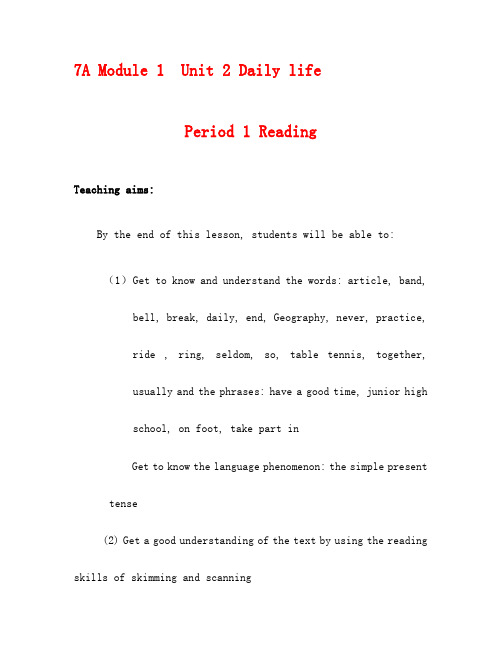
7A Module 1 Unit 2 Daily lifePeriod 1 ReadingTeaching aims:By the end of this lesson, students will be able to: (1)G et to know and understand the words: article, band, bell, break, daily, end, Geography, never, practice,ride , ring, seldom, so, table tennis, together,usually and the phrases: have a good time, junior highschool, on foot, take part inGet to know the language phenomenon: the simple present tense(2) Get a good understanding of the text by using the reading skills of skimming and scanning(3)Cultivate students’ love for our life .Teaching focus:(1)Master the basic information of the article(2)Get to know the language phenomenon: the simple present tenseTeaching difficulties:Guess the meaning of new words according to the context Teaching methods:Task-based teaching and learningTeaching aids:Multi-media device, a blackboardTeaching procedures:Step1 BrainstormBoys and girls, today we are going to learn Unit2 Daily life. When it comes to daily life ,can you say some phrases about it? Such as “go to school”Meanwhile write down their phrases on the blackboard. Then add the phrases on page16 part AStep2 PresentationPresent these sentence patterns : I … every day. / I … once or twice a week./I never…. on the blackboard.Explain the words :never, once, twiceAsk students to talk about their daily life using the sentence patterns above and the phrases we brainstormed and learned just now.Step3 Reading∙SkimmingPresent the title and the three pictures on page 17 and let students predict Sam’s school life . Then finish B1 on page16.Read the first sentence of each paragraph in the article on page 17. Then finish the questions of B2 on page 16. Pay attention to letting them understand the word: so and the phrases: junior high school, on foot, have a good time∙ScanningLet students skim the article quickly, then finish D1 on page 19 by themselves. Make them understand the words: Geography, practice and the phrase: take part inEncourage students to read the article carefully, then letthem try to guess the meaning of the new words in italics in c1 of page 18.Step 4 More exerciseFinish the exercise of C2.Step 5 Read the textFollow the tape and read the text. Pay attention to the pronunciations and the tones.Step 6 Retell the articleAccording to the pictures and the key words ,try to retell the text paragraph by paragraph.Homework:Oral work: Read the text by imitating the tape recording.∙Written work: Complete part 1 on exercise book P7. ∙。
牛津上海版七年级上Unit2复习教案
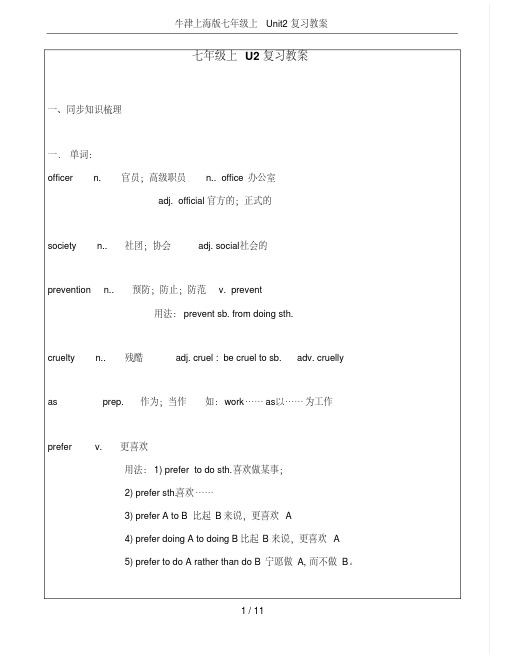
七年级上U2复习教案一、同步知识梳理一.单词:officer n. 官员;高级职员 n.. office 办公室adj. official 官方的;正式的society n.. 社团;协会 adj. social 社会的prevention n.. 预防;防止;防范 v. prevent用法:prevent sb. from doing sth.cruelty n.. 残酷 adj. cruel : be cruel to sb. adv. cruelly as prep. 作为;当作如:work……as 以……为工作prefer v. 更喜欢用法:1) prefer to do sth. 喜欢做某事;2) prefer sth. 喜欢……3) prefer A to B 比起B来说,更喜欢 A4) prefer doing A to doing B 比起B来说,更喜欢 A5) prefer to do A rather than do B 宁愿做A, 而不做B。
care n. 照料;照顾 adj. careful / careless n. carefulness / carelessness词组: take care of 照顾safely adv. 安全地; adj. safe n. safetypolice n. 警方该词做警方解释时是集体名词,没有复数形式,但后面的谓语动词要用复数。
thief n. 窃贼;小偷复数形式是:thieves v. thieve 偷missing adj. 失踪的 a missing boy = a lost boy 迷路的男孩v. missadj. missed二.词组:照看好look after …… well为……筹钱raise money for……保证做…… promise to do ……守护我们的家 guard our homes在很多方面 in many ways对……残忍be cruel to ……找到失踪的人 find lost people保护……使免受…… protect …… from浅棕色 light brown阻止,使免于…… keep……from欢迎来到…… welcome to ……把……扔在马路上 leave something in the street.愿意做…… would like to do something给……一碗水喝 give somebody a bowl of water to drink把……作为宠物keep …… as somebody’s pet三.课文中的语法点need 的用法:need 是个重要的词。
沪教牛津版广州英语七年级上册Unit2讲义(精品资料).doc

【最新整理,下载后即可编辑】英语初一专题系列之Unit 2 Daily life1. between…and… _________________________2. 把某物送给某人________________________3. once or twice a week_________________________4. on foot_________________________5. 过得愉快_________________________6. 放学后_________________________7. 教某人做某事_________________________ 8. in the middle of _________________________9. 参加_________________________ 10. by doing sth_________________________11. How often _________________________ 12. junior high school _________________________13乘公共汽车_________________________ 14. 在…末尾_________________________15起床_________________________ 16. play the piano_________________________1. Listen to a boy talking about his weekend.【考点聚焦】Talk about意为“___________”,后面既可以接人, 也可以接物。
Let’s talk about the problem.The students are talking about the new teacher.2. 辨析That’s right. All right与That’s all right[考点聚焦]①That’s right ___________。
初中英语沪教版七年级上册Unit2《Reading A day at school》优质课公开课教案教师资格证面试试讲教案
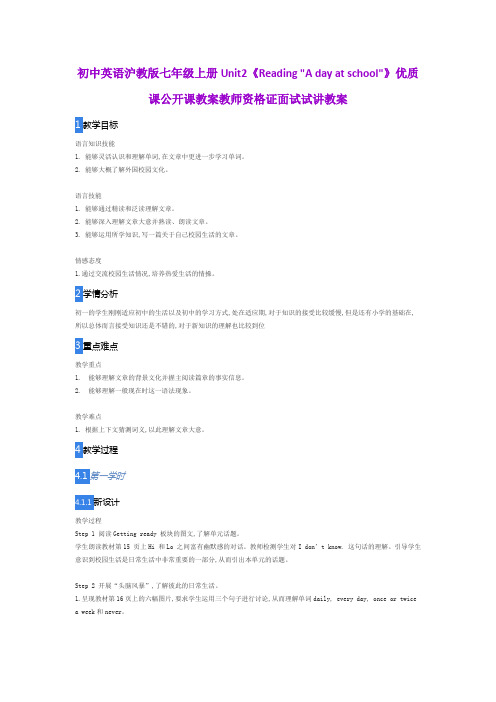
初中英语沪教版七年级上册Unit2《Reading "A day at school"》优质课公开课教案教师资格证面试试讲教案1教学目标语言知识技能1. 能够灵活认识和理解单词,在文章中更进一步学习单词。
2. 能够大概了解外国校园文化。
语言技能1. 能够通过精读和泛读理解文章。
2. 能够深入理解文章大意并熟读、朗读文章。
3. 能够运用所学知识,写一篇关于自己校园生活的文章。
情感态度1.通过交流校园生活情况,培养热爱生活的情操。
2学情分析初一的学生刚刚适应初中的生活以及初中的学习方式,处在适应期,对于知识的接受比较缓慢,但是还有小学的基础在,所以总体而言接受知识还是不错的,对于新知识的理解也比较到位3重点难点教学重点1. 能够理解文章的背景文化并握主阅读篇章的事实信息。
2. 能够理解一般现在时这一语法现象。
教学难点1. 根据上下文猜测词义,以此理解文章大意。
4教学过程4.1第一学时新设计教学过程Step 1 阅读Getting ready 板块的图文,了解单元话题。
学生朗读教材第15 页上Hi 和Lo 之间富有幽默感的对话。
教师检测学生对I don’t know. 这句话的理解。
引导学生意识到校园生活是日常生活中非常重要的一部分,从而引出本单元的话题。
Step 2 开展“头脑风暴”,了解彼此的日常生活。
1.呈现教材第16页上的六幅图片,要求学生运用三个句子进行讨论,从而理解单词daily, every day, once or twicea week和never。
沪教牛津版七年级上册英语Unit 2 课时2 Reading II

【点拨】根据上下文意思可知,“我几 乎不喝绿茶”。
15.【中考·天水】___C___wonderfulTheReaderis! ManypeopleenjoytheTVprogram.
A. WhatB. Howa C. HowD. Whata
基础巩固练
答案呈现
16 seldom 17 Yes; do
21 neverlate 22 playtabletennis
18 Howlong
23 haveagoodtime
19 Whendoes
24 What; morningbreak
20 so; walk
25 takespartin
26 B 27 B 28 A 29 A 30 D
A. I often help her with Chinese.
B. Her father works in a hospital.
C. She has a round face.
D. They all like Chinese food.
E. She is good to her students.
A. IoftenhelpherwithChinese. B. Herfatherworksinahospital. C. Shehasaroundface. D. TheyalllikeChinesefood. E. Sheisgoodtoherstudents. F. TheywillgobacktoCanada.
PeterandIareinthesamegrade, ______27weareindifferentclasses. 26. A. anB. aC. theD./ 27B. A. orB. butC. soD. and
Starter_Unit2_Period2(2a-2e)名师教案

【通过本单元的学习学生需掌握哪些综合技能】学会正确书写字母I—R。知道顺序,熟悉大小写,了解I、O在重读开、闭音节中的读音。学会身边常见物品的英文单词。能够运用本单元的句型向别人询问和回答物品的英文名称,求助单词的拼写。
教学目标
1.语言知识目标:
1)能掌握以下词汇:字母Ii ~ Rr,缩略词P, NBA, kg
2)能掌握字母Ii ~ Rr的字母顺序,读音及书写。
2.情感态度价值观目标:
让学生们在相互问候的过程中,学会礼貌待人,与同学之间友好相处。
教学重难点
1.教学重点:
能掌握字母Ii ~ Rr的字母顺序,读音及书写。
2. Let Ss try to write down the missing letters. Check the answers with your partner.
3. Let some Ss come the Bb and write missing letters on the Bb.
Read and talk
1. Let Ss look at the pictures in 2e. Let some Ss read the letters below each picture.
2. Let some Ss talk about the meaning of each picture.
1.通过观察比较书写体与印刷体的不同,教会学生按正确的笔划顺序书写,为后面的单词书写做准备。
上海版英语七年级上Unit2Dailylife教案
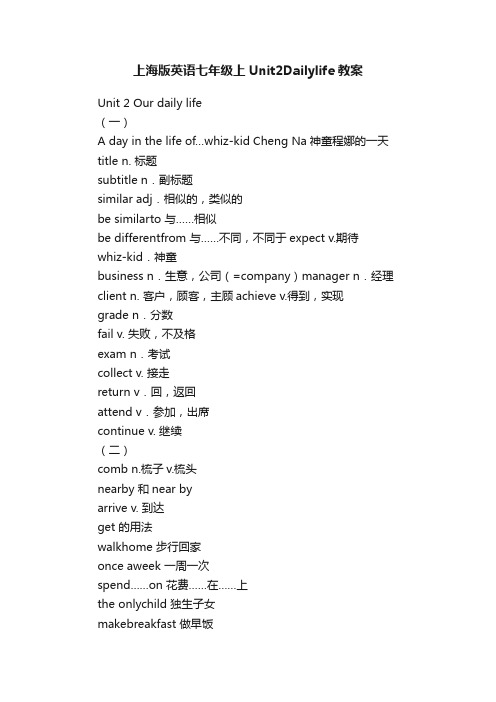
上海版英语七年级上Unit2Dailylife教案Unit 2 Our daily life(一)A day in the life of…whiz-kid Cheng Na神童程娜的一天title n. 标题subtitle n.副标题similar adj.相似的,类似的be similarto 与……相似be differentfrom 与……不同,不同于expect v.期待whiz-kid.神童business n.生意,公司(=company)manager n.经理client n. 客户,顾客,主顾achieve v.得到,实现grade n.分数fail v. 失败,不及格exam n.考试collect v. 接走return v.回,返回attend v.参加,出席continue v. 继续(二)comb n.梳子v.梳头nearby 和near byarrive v. 到达get 的用法walkhome 步行回家once aweek 一周一次spend……on 花费……在……上the onlychild 独生子女makebreakfast 做早饭(三)in the green dress穿着绿色礼服的, in the redshirt穿着红色衬衫的(在此注意in 的用法)holdcousin 表兄妹或表姐弟, nephew外甥或外甥女exceptfor 除……之外(四)completetimetablequarter , a quarter 一刻钟(=15分钟)biology 生物-----其它科目?go on foot = walk 走路去,步行前往on weekdays 和on the weekend二重点难点解析(一)1. Cheng Na, one of the top students inGuangzhou.程娜,广州的高材生之一。
*one of the top students = one of the beststudents高材生之一"one of+名词复数”表示“……之一”2. all of her family work in herbusiness.她所有的家人都在她的公司工作。
沪教版七年级英语上册全套教案
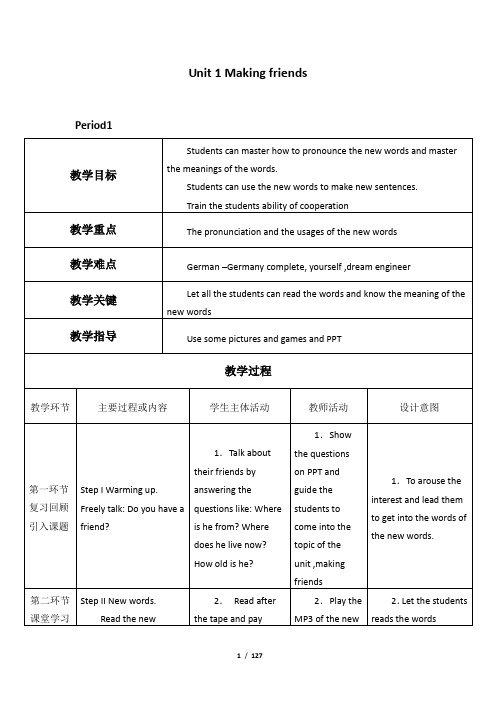
2.Choose the right pronunciation of the words.
6.Finish theexercise given on the sheet.
6.Collectthe mistakes in the students'exercise.
3.To make them get familiar with the pronunciation and the spelling of the new words.
4.Train the students'ability to cooperate. Let the students in different levels can take part in the activity.
2.Play the MP3 of the newwords for them and lead them to read in a proper way.
3.Prepare a number game, and show it on ppt and give different groups marks according to the questions they answer.
6.To check theStudents'learningsituation.
第四环节课时小结
stepVII
How many words do you master?
Write them down in your sheet
7.Remember the words you learn and spell them out
沪教牛津版七年级上册英语 Unit2 课时2 Reading II 习题课件
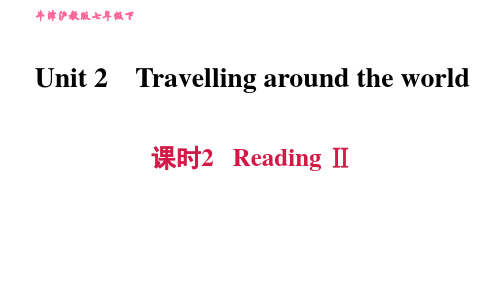
14.【中考·海南】Sansha, a beautiful city, lies ___A___ the
south of China.
A. in
意:三沙,一座漂 亮的城市,坐落在中国南方。in 表示“在……范围 里面”; on表示“和……接壤”; to表示“不接 壤”。三沙市是属于中国的,在中国内部,故选A。
You will swim there without danger ____i_f____ 37 you remember these rules.
能力提升练
good, if, buy, when, boat, by, tell, beach, for, hungry, perfect, other
牛津沪教版七年级下
Unit 2 Travelling around the world
课时2 Reading Ⅱ
习题链接
提示:点击 进入习题
1 Europe 2 perfect 3 possible 4 preferred 5 lies
基础巩固练
6 French 7 East 8 skiing 9 beaches 10 reading
基础巩固练
talk about, a place of interest, in the center of, by the sea, summer holiday 18. On weekends there are lots of people ____b_y__th__e_s_e_a____. They lie on the beach and talk.
基础巩固练
talk about, a place of interest, in the center of, by the sea, summer holiday 19. There is a big supermarket __in__th__e_c_e_n_t_er__o_f__this city. Let’s go shopping there.
初中英语沪教版七年级上册Unit2《Fang Fang's daily life》优质课教案比赛获奖教案公开课教师面试试讲教案
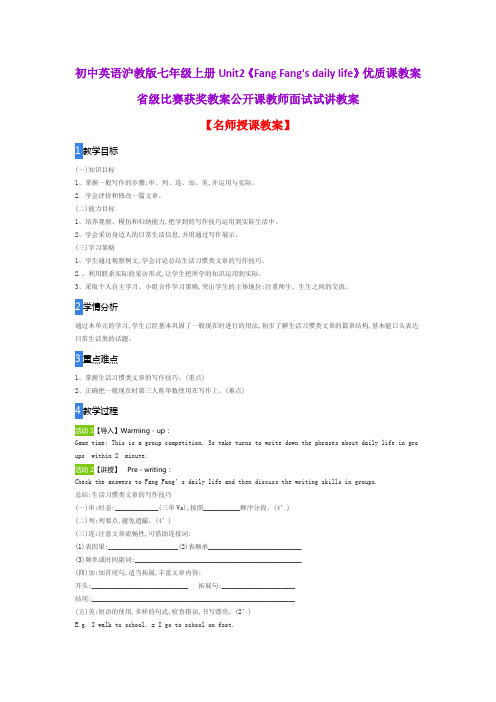
初中英语沪教版七年级上册Unit2《Fang Fang's daily life》优质课教案省级比赛获奖教案公开课教师面试试讲教案【名师授课教案】1教学目标(一)知识目标1、掌握一般写作的步骤:审、列、连、加、美,并运用与实际。
2. 学会评价和修改一篇文章。
(二)能力目标1、培养观察、模仿和归纳能力,把学到的写作技巧运用到实际生活中。
2、学会采访身边人的日常生活信息,并用通过写作展示。
(三)学习策略1、学生通过观察例文,学会讨论总结生活习惯类文章的写作技巧。
2.、利用联系实际的采访形式,让学生把所学的知识运用到实际。
3、采取个人自主学习、小组合作学习策略,突出学生的主体地位;注重师生、生生之间的交流。
2学情分析通过本单元的学习,学生已经基本巩固了一般现在时进行的用法,初步了解生活习惯类文章的篇章结构,基本能口头表达日常生活类的话题。
3重点难点1、掌握生活习惯类文章的写作技巧。
(重点)2、正确把一般现在时第三人称单数使用在写作上。
(难点)4教学过程1【导入】Warming-up:Game time: This is a group competition. Ss take turns to write down the phrases about daily life in gro ups within 2 minute.2【讲授】Pre-writing:Check the answers to Fang Fang’s daily life and then discuss the writing skills in groups.总结:生活习惯类文章的写作技巧(一)审:时态:_____________(三单Vs),按照___________顺序分段。
(4’)(二)列:列要点,避免遗漏。
(4’)(三)连:注意文章流畅性,可借助连接词:(1)表因果:_____________________(2)表顺承____________________________(3)频率或时间副词:__________________________________________________(四)加:加首尾句,适当拓展,丰富文章内容:开头:_____________________________ 拓展句:______________________结尾:_____________________________________________________________(五)美:短语的使用,多样的句式,检查错误,书写漂亮。
初中英语沪教版七上Unit2《Fang Fang's daily life》省级名师优质课教案比赛获奖教案示范课教案公开课教案
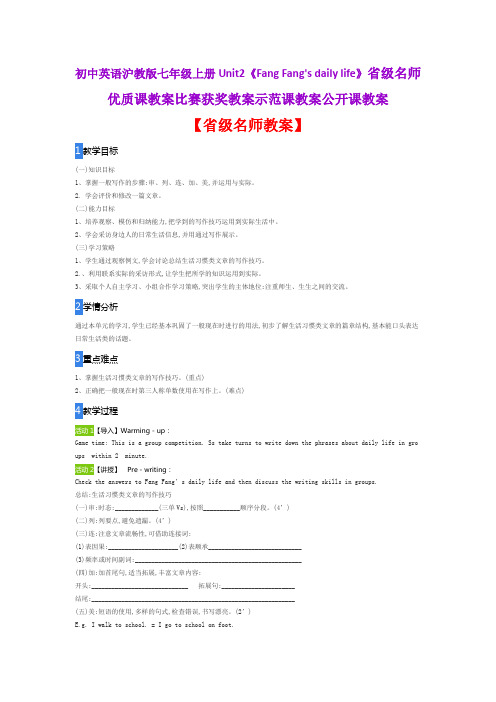
初中英语沪教版七年级上册Unit2《Fang Fang's daily life》省级名师优质课教案比赛获奖教案示范课教案公开课教案【省级名师教案】1教学目标(一)知识目标1、掌握一般写作的步骤:审、列、连、加、美,并运用与实际。
2. 学会评价和修改一篇文章。
(二)能力目标1、培养观察、模仿和归纳能力,把学到的写作技巧运用到实际生活中。
2、学会采访身边人的日常生活信息,并用通过写作展示。
(三)学习策略1、学生通过观察例文,学会讨论总结生活习惯类文章的写作技巧。
2.、利用联系实际的采访形式,让学生把所学的知识运用到实际。
3、采取个人自主学习、小组合作学习策略,突出学生的主体地位;注重师生、生生之间的交流。
2学情分析通过本单元的学习,学生已经基本巩固了一般现在时进行的用法,初步了解生活习惯类文章的篇章结构,基本能口头表达日常生活类的话题。
3重点难点1、掌握生活习惯类文章的写作技巧。
(重点)2、正确把一般现在时第三人称单数使用在写作上。
(难点)4教学过程1【导入】Warming-up:Game time: This is a group competition. Ss take turns to write down the phrases about daily life in gro ups within 2 minute.2【讲授】Pre-writing:Check the answers to Fang Fang’s daily life and then discuss the writing skills in groups.总结:生活习惯类文章的写作技巧(一)审:时态:_____________(三单Vs),按照___________顺序分段。
(4’)(二)列:列要点,避免遗漏。
(4’)(三)连:注意文章流畅性,可借助连接词:(1)表因果:_____________________(2)表顺承____________________________(3)频率或时间副词:__________________________________________________(四)加:加首尾句,适当拓展,丰富文章内容:开头:_____________________________ 拓展句:______________________结尾:_____________________________________________________________(五)美:短语的使用,多样的句式,检查错误,书写漂亮。
初中英语沪教版七年级上册Unit2《The daily life of Jason's mother》优质课教案公开课教师面试试讲教案
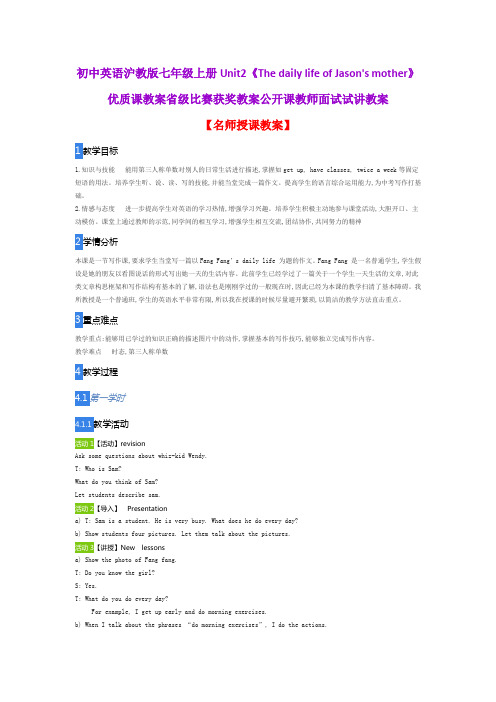
初中英语沪教版七年级上册Unit2《The daily life of Jason's mother》优质课教案省级比赛获奖教案公开课教师面试试讲教案【名师授课教案】1教学目标1.知识与技能能用第三人称单数对别人的日常生活进行描述,掌握如get up, have classes, twice a week等固定短语的用法。
培养学生听、说、读、写的技能,并能当堂完成一篇作文。
提高学生的语言综合运用能力,为中考写作打基础。
2.情感与态度进一步提高学生对英语的学习热情,增强学习兴趣。
培养学生积极主动地参与课堂活动,大胆开口、主动模仿。
课堂上通过教师的示范,同学间的相互学习,增强学生相互交流,团结协作,共同努力的精神2学情分析本课是一节写作课,要求学生当堂写一篇以Fang Fang’s daily life 为题的作文。
Fang Fang 是一名普通学生,学生假设是她的朋友以看图说话的形式写出她一天的生活内容。
此前学生已经学过了一篇关于一个学生一天生活的文章,对此类文章构思框架和写作结构有基本的了解,语法也是刚刚学过的一般现在时,因此已经为本课的教学扫清了基本障碍。
我所教授是一个普通班,学生的英语水平非常有限,所以我在授课的时候尽量避开繁琐,以简洁的教学方法直击重点。
3重点难点教学重点:能够用已学过的知识正确的描述图片中的动作,掌握基本的写作技巧,能够独立完成写作内容。
教学难点时态,第三人称单数4教学过程4.1第一学时教学活动1【活动】revisionAsk some questions about whiz-kid Wendy.T: Who is Sam?What do you think of Sam?Let students describe sam.2【导入】Presentationa) T: Sam is a student. He is very busy. What does he do every day?b) Show students four pictures. Let them talk about the pictures.3【讲授】New lessonsa) Show the photo of Fang fang.T: Do you know the girl?S: Yes.T: What do you do every day?For example, I get up early and do morning exercises.b) When I talk about the phrases “do morning exercises”, I do the actions.。
- 1、下载文档前请自行甄别文档内容的完整性,平台不提供额外的编辑、内容补充、找答案等附加服务。
- 2、"仅部分预览"的文档,不可在线预览部分如存在完整性等问题,可反馈申请退款(可完整预览的文档不适用该条件!)。
- 3、如文档侵犯您的权益,请联系客服反馈,我们会尽快为您处理(人工客服工作时间:9:00-18:30)。
2.Let the students get the general idea of the text..
3.To make them get familiar with the details of the text and train their ability of reading
25
第三环节 课堂练习
Step five: exercise
6.Finish the exercise in Part C and D
6.Help them to find the details in the text.
6. To train the students’ reading ability .
7. Prepare for the writing
5
第五环节 课后作业
Homework
1. Read the text fluently
2 write a passage to talk about your daily life
Hand out a sheet which contain the request of writing the passage
Never , seldom , always , often , once, twice , three times etc.
3. play the Mp3 of the text and let students follow the reading
4. show the questions on a sheet like :
4. Train the students’ ability to get some detailed information while reading a passage and make students read the text correctly.
5.Provie the chances to students to show themselves and practice speaking
What does he often do in the morning break?
5. using the pictures and the key words to talk about Sam’s daily life
2. Show the question: How often do you do…..?
教学重点
The comprehension of the passage
教学难点
Some difficult words and expressions
教学关键
Students can use their own words to describe the seasons
教法与学法导
Reading competition, cooperation, self-study.
3. Read after the MP3 and imitate the intonation of the MP3
4. answer the questions according to the text and find some detailed information about Sam,like : Is Sam’s school far from his home? How does he go to school? What does he usually study in the morning ,?
Period 2
课题
Unit 2 Daily life
课型
Reading
备课时间
1 period
教
材
分
析
教学目标
1.The students can getthe main idea of the passage.
2.Their ability of reading and cooperation is trained .
Strengthen the comprehension of the text.
课
堂
教
学
流
程
Free talk --- Preparation ---Reading competition ----- Discussion---Homework .
效
果
评
价
与
反
思
5
第四环节 课时小结
step Six: Sum up
7 Sum up
How to use the simple present tense to talk about the daily life
7. Show a PPT to sum up : master the important structure : How often do you do ….?
1. Talk with students freely about the weekends
1.To arouse the interest and lead them to get into the topic about seasons
5
第二环节 观察操作、探索归纳平移的作法
Step two: 1.Talk about the picture in Part A.
教学环节
主要教学步骤或内容
学生主体活动
教师活动
设计意图
时间
分配
第一环节 复习回顾平移的基本性质,引入课题
Step one: Free talk :
What do you usually do at weekends?
1.Talk with teachers what do you usually do at weekends
Step three: while-reading.
Reading comprehension.
Step four: Discussion
2. Answer the questions like How often do you brush your teeth? How often do you watch television? How often do you play table tennis , How often do you ride a bicycle , how often do you play the piano
